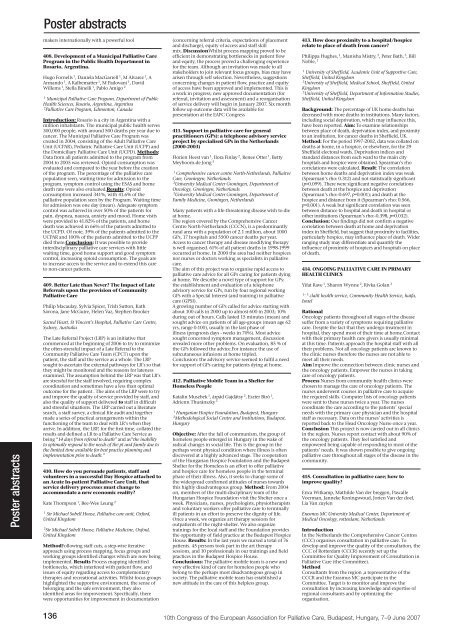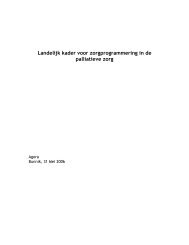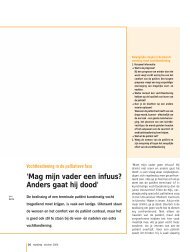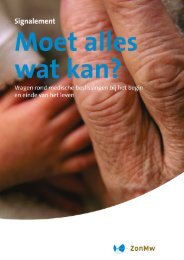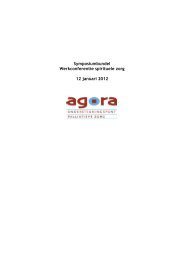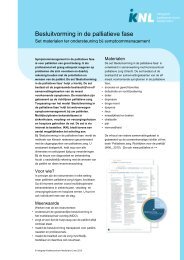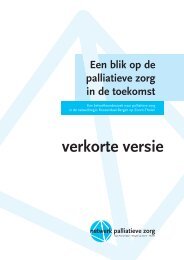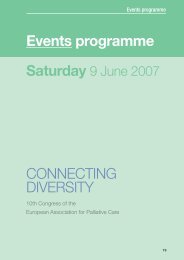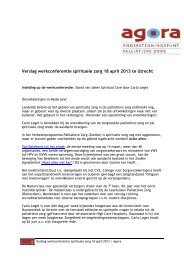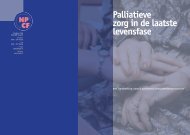Poster abstracts CONNECTING DIVERSITY
Poster abstracts CONNECTING DIVERSITY
Poster abstracts CONNECTING DIVERSITY
You also want an ePaper? Increase the reach of your titles
YUMPU automatically turns print PDFs into web optimized ePapers that Google loves.
<strong>Poster</strong> <strong>abstracts</strong><br />
<strong>Poster</strong> <strong>abstracts</strong><br />
makers internationally with a powerful tool<br />
408. Development of a Municipal Palliative Care<br />
Program in the Public Health Department in<br />
Rosario, Argentina.<br />
Hugo Fornells 1 , Daniela MacGarrell 1 , M Alvarez 1 , A<br />
Armando 1 , A Kalbematter 1 , M Padovani 1 , David<br />
Willems 1 , Stella Binelli 1 , Pablo Amigo 2<br />
1<br />
Municipal Palliative Care Program, Department of Public<br />
Health Sciences, Rosario, Argentina, Argentina<br />
2<br />
Palliative Care Program, Edmonton, Canada<br />
Introduction: Rosario is a city in Argentina with a<br />
million inhabitants. The municipal public health serves<br />
300,000 people, with around 500 deaths per year due to<br />
cancer. The Municipal Palliative Care Program was<br />
created in 2004, consisting of the Adult Palliative Care<br />
Unit (UCPAR), Pediatric Palliative Care Unit (UCPP) and<br />
the Domiciliary Palliative Care Unit (UCPD). Methods:<br />
Data from all patients admitted to the program from<br />
2004 to 2005 was reviewed. Opioid consumption was<br />
evaluated and compared to the year before the creation<br />
of the program. The percentage of the palliative care<br />
population seen, waiting time for admission to the<br />
program, symptom control using the ESAS and home<br />
death rate were also evaluated.Results: Opioid<br />
consumption increased 341%, with 41.6% of the<br />
palliative population seen by the Program. Waiting time<br />
for admission was one day (mean). Adequate symptom<br />
control was achieved in over 50% of the patients for<br />
pain, dyspnea, nausea, anxiety and mood. Home visits<br />
were provided to 41.82% of the patients, and home<br />
death was achieved in 66% of the patients admitted to<br />
the UCPD. Of note, 39% of the patients admitted to the<br />
UCPAR and 100% of the patients admitted to the UCPP<br />
died there.Conclusion: It was possible to provide<br />
interdisciplinary palliative care services with little<br />
waiting time, good home support and good symptom<br />
control, increasing opioid consumption. The goals are<br />
to increase access to the service and to extend this care<br />
to non-cancer patients.<br />
409. Better Late than Never? The Impact of Late<br />
Referrals upon the provision of Community<br />
Palliative Care<br />
Philip Macaulay, Sylvia Spicer, Trish Sutton, Kath<br />
Savona, Jane McGuire, Helen Vaz, Stephen Brooker<br />
Sacred Heart, St Vincent’s Hospital, Palliative Care Centre,<br />
Sydney, Australia<br />
The Late Referral Project (LRP) is an initiative that<br />
commenced at the beginning of 2006 to try to minimize<br />
the often-stressful impact of a Late Referral to the<br />
Community Palliative Care Team (CPCT) upon the<br />
patient, the staff and the service as a whole. The LRP<br />
sought to ascertain the external pathways for LR’s so that<br />
they might be monitored and the reasons for lateness<br />
examined. The assumption behind the LRP was that LR’s<br />
are stressful for the staff involved, requiring complex<br />
coordination and sometimes have a less than optimal<br />
outcome for the patient . The aims of the LRP were to try<br />
and improve the quality of service provided by staff, and<br />
also the quality of support delivered to staff in difficult<br />
and stressful situations. The LRP carried out a literature<br />
search, a staff survey, a clinical file audit and together<br />
made a series of practical arrangements within the<br />
functioning of the team to deal with LR’s when they<br />
arrive. In addition, the LRP, for the first time, collated the<br />
results and defined a LR to a Palliative Care Service as<br />
being “14 days from referral to death” and as”the inability<br />
to optimally respond to the needs of the pt and family due to<br />
the limited time available for best practice planning and<br />
implementation prior to death.”<br />
410. How do you persuade patients, staff and<br />
volunteers in a successful Day Hospice attached to<br />
an Acute In-patient Palliative Care Unit, that<br />
service delivery processes must change to<br />
accommodate a new economic reality?<br />
Kate Thompson 1 , Bee-Wee Leung 2<br />
1<br />
Sir Michael Sobell House, Palliative care unit, Oxford,<br />
United Kingdom<br />
2<br />
Sir Michael Sobell House, Palliative Medicine, Oxford,<br />
United Kingdom<br />
MethodFollowing staff cuts, a step-wise iterative<br />
approach using process mapping, focus groups and<br />
working groups identified changes which are now being<br />
implemented. Results Process mapping identified<br />
bottlenecks, which interfered with patient flow, and<br />
issues of equity regarding access to complementary<br />
therapies and recreational activities. Whilst focus groups<br />
highlighted the supportive environment, the sense of<br />
belonging and the safe environment, they also<br />
identified areas for improvement. Specifically, there<br />
were opportunities for improvement in documentation<br />
(concerning referral criteria, expectations of placement<br />
and discharge), equity of access and staff skill<br />
mix. DiscussionWhilst process mapping proved to be<br />
efficient in demonstrating bottlenecks in patient flow<br />
and equity, the process proved a challenging experience<br />
for the team. Although an invitation was made to all<br />
stakeholders to join relevant focus groups, bias may have<br />
arisen through self selection. Nevertheless, suggestions<br />
concerning changes in patient flow, practice and equity<br />
of access have been approved and implemented. This is<br />
a work in progress; new approved documentation (for<br />
referral, invitation and assessment) and a reorganisation<br />
of service delivery will begin in January 2007. Six month<br />
follow up outcome data will be available for<br />
presentation at the EAPC Congress<br />
411. Support in palliative care for general<br />
practitioners (GPs): a telephone advisory service<br />
project by specialised GPs in the Netherlands<br />
(2000-2003)<br />
Florien Heest van 1 , Ilora Finlay 2 , Renee Otter 1 , Betty<br />
Meyboom-de Jong 3<br />
1<br />
Comprehensive cancer centre North-Netherlands, Palliaitve<br />
Care, Groningen, Netherlands<br />
2<br />
University Medical Center Groningen, Department of<br />
Oncology, Groningen, Netherlands<br />
3<br />
University Medical Center Groningen, Department of<br />
Family Medicine, Groningen, Netherlands<br />
Many patients with a life-threatening disease wish to die<br />
at home.<br />
The region covered by the Comprehensive Cancer<br />
Centre North-Netherlands (CCCN), is a predominantly<br />
rural area with a population of 2.1 million, about 1000<br />
GPs, 17 hospitals and 5500 cancer deaths per year.<br />
Access to cancer therapy and disease modifying therapy<br />
is well organised. 61% of all patient deaths in 1998-1999<br />
occurred at home. In 2000 the area had neither hospices<br />
nor nurses or doctors working as specialists in palliative<br />
care.<br />
The aim of this project was to organise rapid access to<br />
palliative care advice for all GPs caring for patients dying<br />
at home. We describe a novel type of support for GPs:<br />
the establishment and evaluation of a telephone<br />
advisory service for GPs, run by four regional working<br />
GPs with a Special Interest (and training) in palliative<br />
care (GPSI).<br />
A growing number of GPs called for advice starting with<br />
about 100 calls in 2000 up to almost 600 in 2003; 10%<br />
during out of hours. Calls lasted 15 minutes (mean) and<br />
sought advice on patients of all age-groups (mean age 62<br />
yrs, range 0-100), usually in the last phase of<br />
illness (prognosis days - weeks in 70%). Most advice<br />
sought concerned symptom management, discussion<br />
revealed more other problems. On evaluation, 85 % of<br />
the GPs followed the advice.For instance the use of<br />
subcutaneous infusions at home tripled.<br />
Conclusion: the advisory service seemed to fulfil a need<br />
for support of GPs caring for patients dying at home.<br />
412. Palliative Mobile Team in a Shelter for<br />
Homeless People<br />
Katalin Muszbek 1 , árpád Gajdátsy 2 , Eszter Biró 1 ,<br />
Adrienn Thuránszky 1<br />
1<br />
Hungarian Hospice Foundation, Budapest, Hungary<br />
2<br />
Methodological Social Centre and Institutions, Budapest,<br />
Hungary<br />
Objective: After the fall of communism, the group of<br />
homeless people emerged in Hungary in the wake of<br />
radical changes in social life. This is the group in the<br />
perhaps worst physical condition where illness is often<br />
discovered at a highly advanced stage. The cooperation<br />
of the Hungarian Hospice Foundation and the Budapest<br />
Shelter for the Homeless is an effort to offer palliative<br />
and hospice care for homeless people in the terminal<br />
phase of their illness. Also, it seeks to change some of<br />
the widespread confirmed attitudes of nurses towards<br />
this highly disadvantegous group. Method: From 2004<br />
on, members of the multi-disciplinary team of the<br />
Hungarian Hospice Foundation visit the Shelter once a<br />
week. Physicians, nurses, psychologists, physiotherapists<br />
and voluntary workers offer palliative care to terminally<br />
ill patients in an effort to preserve the dignity of life.<br />
Once a week, we organize art therapy sessions for<br />
outpatients of the night-shelter. We also organize<br />
trainings for the local staff and the Foundation provides<br />
the opportunity of field practice at the Budapest Hospice<br />
House. Results: In the last years we nursed a total of 76<br />
patients. 45 persons took part in the art therapy<br />
sessions, and 10 professionals in our trainings and field<br />
practices in the Budapest Hospice House.<br />
Conclusions: The palliative mobile team is a new and<br />
very effective kind of care for homeless people who<br />
belong to the perhaps most disadvantegous group in<br />
society. The palliative mobile team has established a<br />
new attitude in the care of this helpless group.<br />
413. How does proximity to a hospital/hospice<br />
relate to place of death from cancer?<br />
Philippa Hughes, 1 , Manisha Mistry, 2 , Peter Bath, 3 , Bill<br />
Noble, 1<br />
1<br />
University of Sheffield, Academic Unit of Supportive Care,<br />
Sheffield, United Kingdom<br />
2<br />
University of Sheffield, Medical School, Sheffield, United<br />
Kingdom<br />
3<br />
University of Sheffield, Department of Information Studies,<br />
Sheffield, United Kingdom<br />
Background: The percentage of UK home deaths has<br />
decreased with more deaths in institutions. Many factors,<br />
including social deprivation, which may influence this,<br />
have been reported. Aim: To examine relationships<br />
between place of death, deprivation index, and proximity<br />
to an institution, for cancer deaths in Sheffield, UK.<br />
Method: For the period 1997-2002, data was collated on<br />
deaths at home, in a hospice, or elsewhere, for the 29<br />
Sheffield electoral wards. Deprivation indices and<br />
standard distances from each ward to the main city<br />
hospitals and hospice were obtained. Spearman’s rho<br />
correlations were calculated. Result: The correlation<br />
between home deaths and deprivation index was weak<br />
(Spearman’s rho: 0.312) and not statistically significant<br />
(p=0.099). There were significant negative correlations<br />
between death at the hospice and deprivation<br />
(Spearman’s rho:-0.697, p=0.001); and death at the<br />
hospice and distance from it (Spearman’s rho: 0.566,<br />
p=0.001). A weak but significant correlation was seen<br />
between distance to hospital and death in hospital or<br />
other institutions (Spearman’s rho:-0.398, p=0.032).<br />
Conclusion: Our findings did not confirm a negative<br />
correlation between death at home and deprivation<br />
index in Sheffield, but suggest that proximity to facilities,<br />
particularly hospice, may influence place of death. Wider<br />
ranging study may differentiate and quantify the<br />
influence of proximity of hospices and hospitals on place<br />
of death.<br />
414. ONGOING PALLIATIVE CARE IN PRIMARY<br />
HEALTH CLINICS<br />
Yifat Rave 1 , Sharon Wynne 2 , Rivka Golan 3<br />
1– 3<br />
clalit health service, Community Health Service, haifa,<br />
Israel<br />
Rational<br />
Oncology patients throughout all stages of the disease<br />
suffer from a variety of symptoms requiring palliative<br />
care. Despite the fact that they undergo treatment in<br />
hospital, they spend most of their time at home.Contact<br />
with their primary health care givers is usually minimal<br />
at this time. Patients approach the hospital staff with all<br />
their problems. Not all oncology patients are known to<br />
the clinic nurses therefore the nurses are not able to<br />
meet all their needs.<br />
Aim Improve the connection between clinic nurses and<br />
the oncology patients. Empower the nurses in taking<br />
care of oncology patients.<br />
Process Nurses from community health clinics were<br />
chosen to manage the care of oncology patients. The<br />
nurses underwent courses in palliative care to acquire<br />
the required skills. Computer lists of oncology patients<br />
were sent to these nurses twice a year. The nurses<br />
coordinate the care according to the patients’ special<br />
needs with the primary care physician and the hospital<br />
staff as necessary. Data on the nurses’ activities is<br />
reported back to the Head Oncology Nurse once a year.<br />
Conclusion This project is now carried out in all clinics<br />
in the region. Nurses report contact with about 90% of<br />
the oncology patients. They feel satisfied and<br />
empowered being capable of responding to most of the<br />
patients’ needs. It was shown possible to give ongoing<br />
palliative care throughout all stages of the disease in the<br />
community.<br />
415. Consultation in palliative care; how to<br />
improve quality?<br />
Erica Witkamp, Mathilde Van der breggen, Pascalle<br />
Voerman, Janneke Koningswoud, Jorien Van der doel,<br />
Lia Van zuylen<br />
Erasmus MC University Medical Center, Department of<br />
Medical Oncology, rotterdam, Netherlands<br />
Introduction<br />
In the Netherlands the Comprehensive Cancer Centres<br />
(CCC) organises consultation in palliative care. To<br />
develop and improve the quality of the consultation, the<br />
CCC of Rotterdam (CCCR) recently set up the<br />
Committee for Quality Improvement of Consultation in<br />
Palliative Care (the Committee).<br />
Method<br />
Consultants from the region ,a representative of the<br />
CCCR and the Erasmus MC participate in the<br />
Committee. Target is to monitor and improve the<br />
consultation by increasing knowledge and expertise of<br />
regional consultants and by optimizing the<br />
organisation.<br />
136 10th Congress of the European Association for Palliative Care, Budapest, Hungary, 7–9 June 2007


